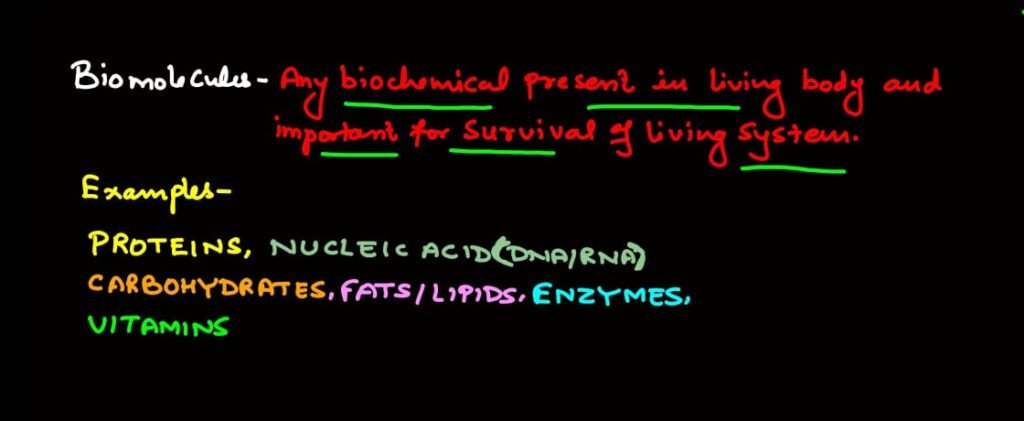Notes of Biomolecules in Simple Language
If you are asked this question, what are biomolecules?
If you want to give a simple answer to this, then you can give a very basic answer, that any organic chemical which is found in the body of living organisms, and which is necessary for the survival of any living organism, is called biomolecules.
But if someone asks you, how do these biomolecules keep any living organisms alive?
Or what do these biomolecules do so that the living system works properly, and life continues, then perhaps there is no direct answer to this, but it will be easier if we understand it with some examples.
All the biochemical interactions that occur in our body or any living organisms actually keep us or any living organisms alive.
For example, if there is no respiration, glucose will not be broken down and there will be a shortage of ATP in the cell, which means there will be a lack of energy in the cell and it will be difficult for it to survive.
In this blog, we will understand the fundamental definition and some basic terms of biomolecules and get answers to these questions,
What are biomolecules?
How are biomolecules separated from living cells?
Apart from biomolecules, what are the inorganic chemicals found in living organisms?
What is the size or molecular weight of biomolecules?
How many parts are biomolecules divided into according to their molecular weight?
What is called ash or ash?
What are the names of biomolecules?
The names of important biomolecules are as follows-
Carbohydrates
Proteins
Lipids or fats
Nucleic Acid DNA or RNA
Enzyme
Amino acids
Vitamins
Fatty acids
Definition of Biomolecules
All the Carbon Compounds that we obtain from Living tissues or any living cells either prokaryotes or eukaryotes can be called as Biomolecules.
However inorganic Compounds & Elements are also present in living system.
Elements Present in Living Matter
Element % Weight of Human Body
Hydrogen (H) 0.5
Oxygen (O) 65.0
Nitrogen (N) 3.3
Sulphur (S) 0.3
Sodium (Na) 0.2
Calcium (Ca) 1.5
Magnesium (Mg) 0.1
Silicon (Si) negligible
Carbon (C) 18.5
How to Isolates Biomolecules?
Steps of Isolation of Biomolecules
What types Organic Compounds are found in Living Organisms?
Take any living tissues (a vegetable or a piece of Liver etc.)
Grind it in trichloro acetic acid (Cl3 CCOOH) – using mortars + pestle
Thick Slurry obtain
Strain (tightly Squeeze) – through cheese cloth or cotton
Two fractions obtains-
1-Filtrate (Acid Soluble Pool) Thousands of organic Compounds are present
2-Retentate (Acid insoluble fraction) also contain organic Molecules of larger Molecular Weight but Sulphate, Phosphate also present
Acid Soluble pool
organic Biomicromolecules
M.W (molecular weights) 18-800.Da (Daltons)
Acid Soluble pool represents roughly the cytoplasmic compositions
Acid insoluble fractions
organic Biomacromolecules
M.W (molecular weights) 10000 Da (Daltons) or above.
Acid insoluble pool represents macromolecules from cytoplasm & organelles. such as Proteins, nucleic acids, polysaccharides, Lipids etc.
What is Ash?
Weighs a small amount of living tissue (a Leaf or liver) = wet weight
Dry it – all water, evaporates = dry weight
If, tissue fully burnt, all carbon compounds are oxidised to gaseous form (CO2, water vapour) and are removed, remain is called Ash, (Contain Ca, Mg etc.)

